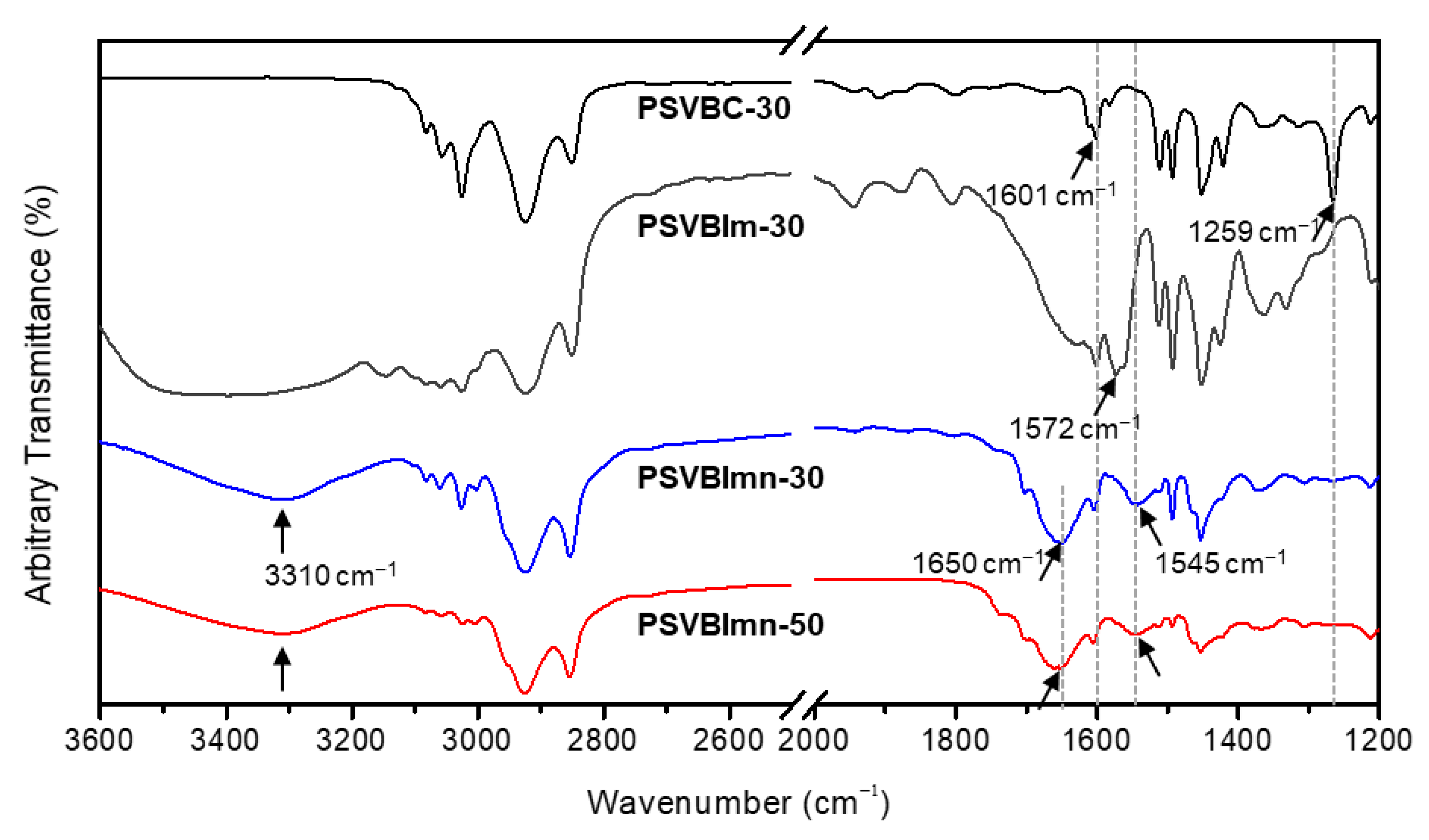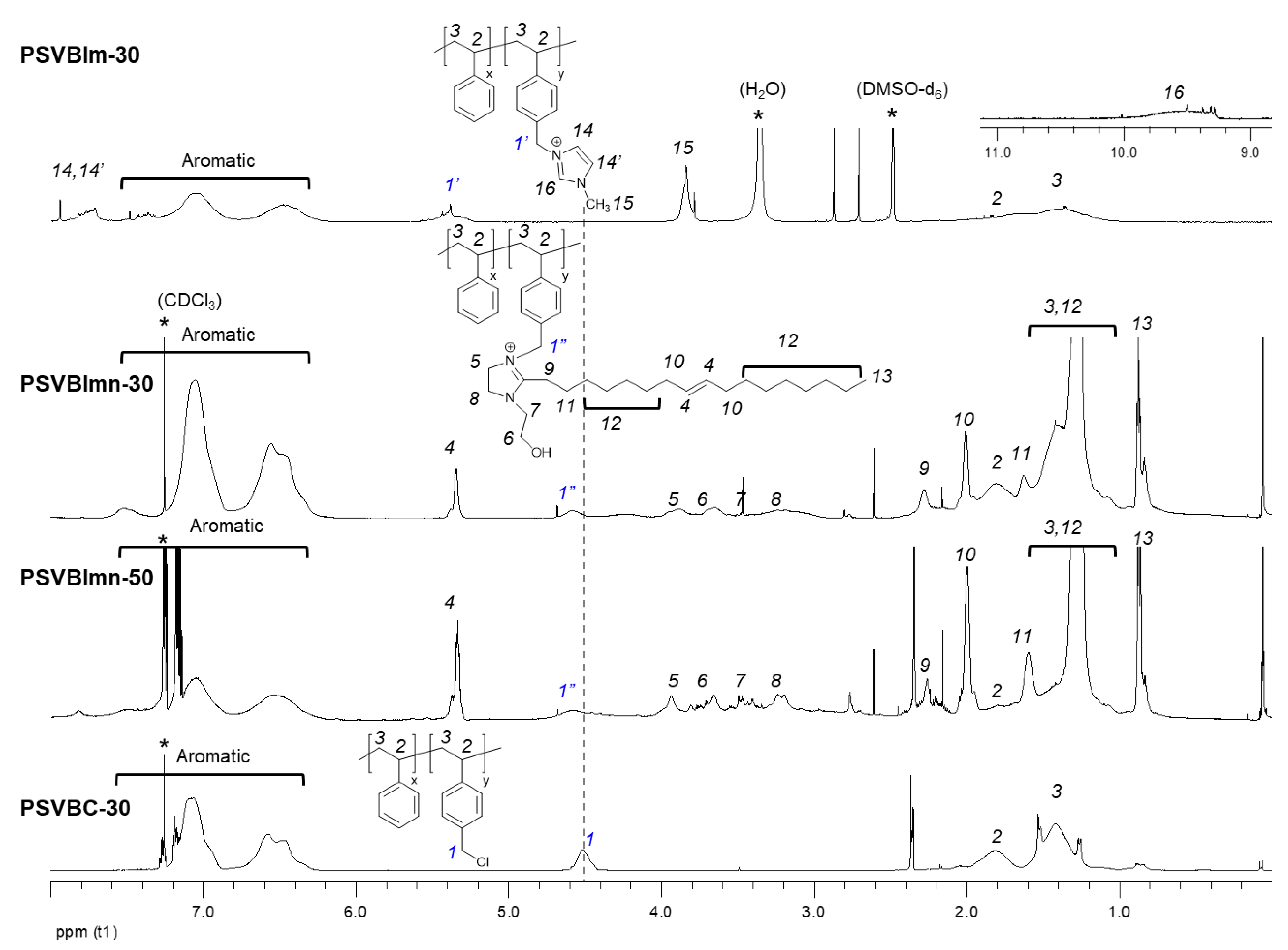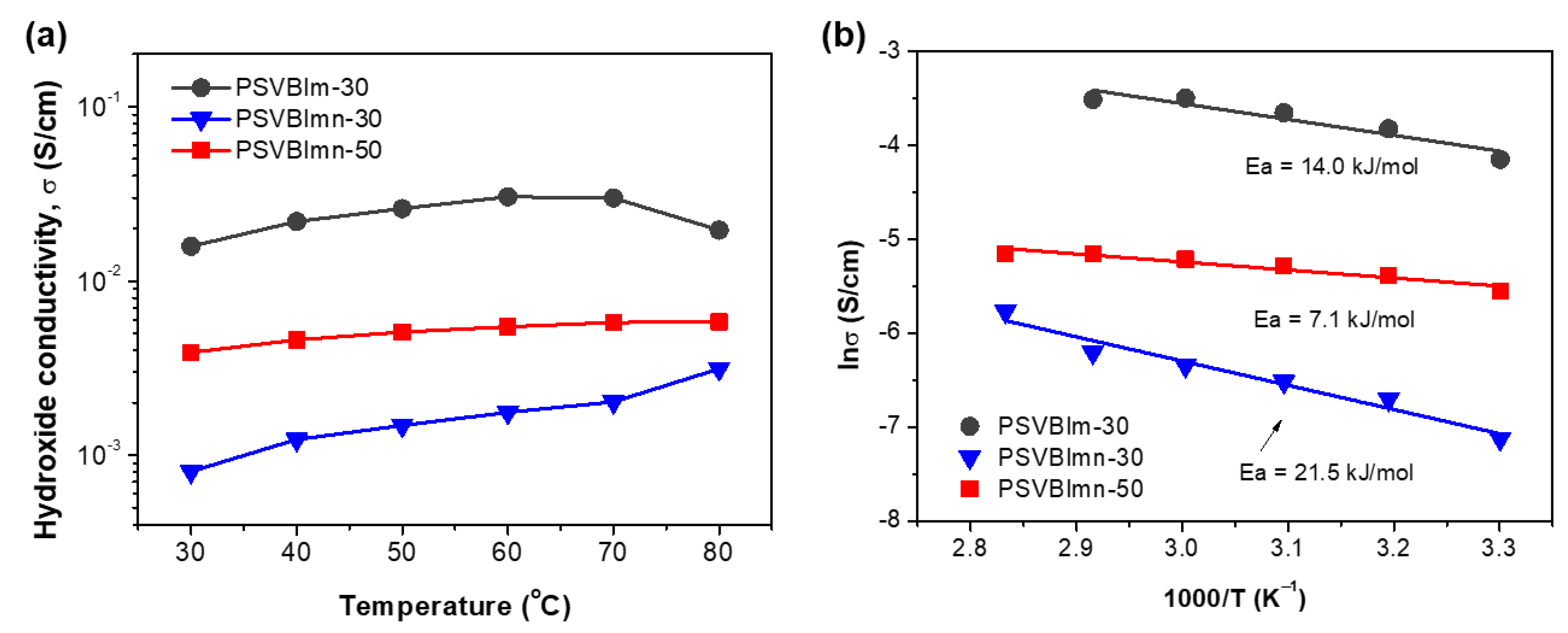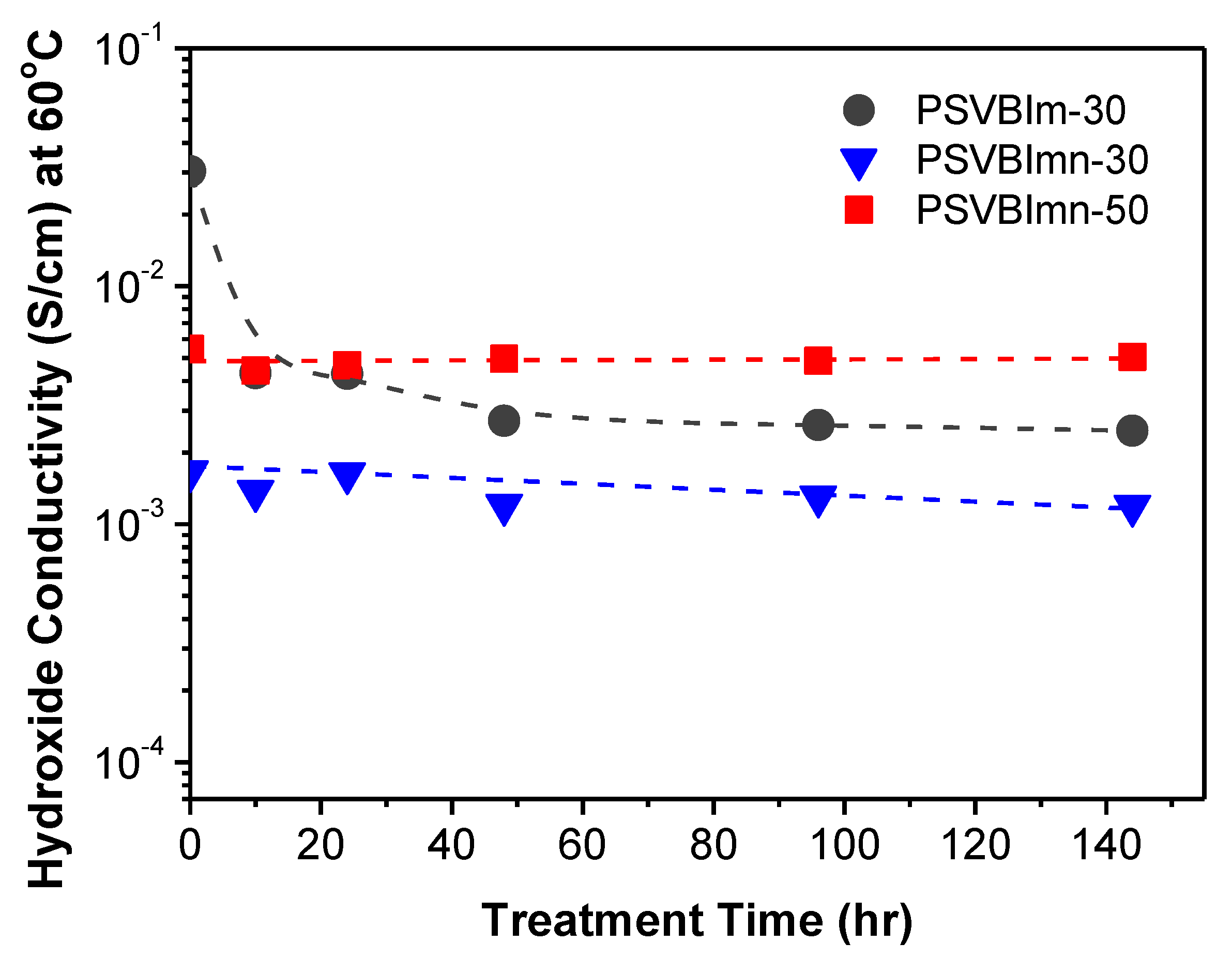Anion Exchange Membranes Based on Imidazoline Quaternized Polystyrene Copolymers for Fuel Cell Applications
Abstract
:1. Introduction
2. Materials and Methods
2.1. Materials
2.2. Syntheses of Quaternized Polystyrene Copolymers
2.3. Preparation of Anion Exchange Membranes Based on Quaternized Polystyrene Copolymers
2.4. Characterization
2.5. Measurements
2.6. Alkaline Stability
2.7. Single-Cell Tests
3. Results and Discussion
3.1. Characterization of Quaternized Polystyrene Copolymers
3.2. Properties of Anion Exchange Membranes Based on Quaternized Polystyrene Copolymers
3.3. Ionic Conductivity of the Anion Exchange Membranes
3.4. Alkaline Stability of the Anion Exchange Membranes
3.5. Fuel Cell Performance
4. Conclusions
Author Contributions
Funding
Institutional Review Board Statement
Informed Consent Statement
Acknowledgments
Conflicts of Interest
References
- Park, C.H.; Lee, C.H.; Guiver, M.D.; Lee, Y.M. Sulfonated hydrocarbon membranes for medium-temperature and low-humidity proton exchange membrane fuel cells (PEMFCs). Prog. Polym. Sci. 2011, 36, 1443–1498. [Google Scholar] [CrossRef] [Green Version]
- Li, W.; Fang, J.; Lv, M.; Chen, C.; Chi, X.; Yang, Y.; Zhang, Y. Novel anion exchange membranes based on polymerizable imidazolium salt for alkaline fuel cell applications. J. Mater. Chem. 2011, 21, 11340. [Google Scholar] [CrossRef] [Green Version]
- Cheng, J.; He, G.; Zhang, F. A mini-review on anion exchange membranes for fuel cell applications: Stability issue and addressing strategies. Int. J. Hydrogen Energy 2015, 40, 7348–7360. [Google Scholar] [CrossRef]
- Pan, Z.F.; An, L.; Zhao, T.S.; Tang, Z.K. Advances and challenges in alkaline anion exchange membrane fuel cells. Prog. Energy Combust. Sci. 2018, 66, 141–175. [Google Scholar] [CrossRef]
- Gutru, R.; Turtayeva, Z.; Xu, F.; Maranzana, G.; Vigolo, B.; Desforges, A. A comprehensive review on water management strategies and developments in anion exchange membrane fuel cells. Int. J. Hydrogen Energy 2020, 45, 19642–19663. [Google Scholar] [CrossRef]
- Serov, A.; Zenyuk, I.V.; Arges, C.G.; Chatenet, M. Hot topics in alkaline exchange membrane fuel cells. J. Power Sources 2018, 375, 149–157. [Google Scholar] [CrossRef]
- Jheng, L.-C.; Tai, C.-K.; Hsu, S.L.-C.; Lin, B.-Y.; Chen, L.; Wang, B.-C.; Chiang, L.-K.; Ko, W.-C. Study on the alkaline stability of imidazolium and benzimidazolium based polyelectrolytes for anion exchange membrane fuel cells. Int. J. Hydrogen Energy 2017, 42, 5315–5326. [Google Scholar] [CrossRef]
- Zhe, S.; Bencai, L.; Feng, Y. Anion-Exchange Membranes for Alkaline Fuel-Cell Applications: The Effects of Cations. Chem. Sus. Chem. 2018, 11, 58–70. [Google Scholar]
- Noonan, K.J.T.; Hugar, K.M.; Kostalik, H.A.; Lobkovsky, E.B.; Abruña, H.D.; Coates, G.W. Phosphonium-Functionalized Polyethylene: A New Class of Base-Stable Alkaline Anion Exchange Membranes. J. Am. Chem. Soc. 2012, 134, 18161–18164. [Google Scholar] [CrossRef]
- Zhang, B.; Gu, S.; Wang, J.; Liu, Y.; Herring, A.M.; Yan, Y. Tertiary sulfonium as a cationic functional group for hydroxide exchange membranes. RSC Adv. 2012, 2, 12683–12685. [Google Scholar] [CrossRef]
- Ponce-González, J.; Whelligan, D.K.; Wang, L.; Bance-Soualhi, R.; Wang, Y.; Peng, Y.; Peng, H.; Apperley, D.C.; Sarode, H.N.; Pandey, T.P.; et al. High performance aliphatic-heterocyclic benzyl-quaternary ammonium radiation-grafted anion-exchange membranes. Energy Environ. Sci. 2016, 9, 3724–3735. [Google Scholar] [CrossRef] [Green Version]
- Zha, Y.; Disabb-Miller, M.L.; Johnson, Z.D.; Hickner, M.A.; Tew, G.N. Metal-Cation-Based Anion Exchange Membranes. J. Am. Chem. Soc. 2012, 134, 4493–4496. [Google Scholar] [CrossRef]
- Di Vona, M.L.; Narducci, R.; Pasquini, L.; Pelzer, K.; Knauth, P. Anion-conducting ionomers: Study of type of functionalizing amine and macromolecular cross-linking. Int. J. Hydrogen Energy 2014, 39, 14039–14049. [Google Scholar] [CrossRef]
- Zhang, Q.; Li, S.; Zhang, S. A novel guanidinium grafted poly(aryl ether sulfone) for high-performance hydroxide exchange membranes. Chem. Commun. 2010, 46, 7495–7497. [Google Scholar] [CrossRef] [PubMed]
- Dang, H.-S.; Jannasch, P. Alkali-stable and highly anion conducting poly(phenylene oxide)s carrying quaternary piperidinium cations. J. Mater. Chem. A 2016, 4, 11924–11938. [Google Scholar] [CrossRef] [Green Version]
- Dang, H.-S.; Jannasch, P. A comparative study of anion-exchange membranes tethered with different hetero-cycloaliphatic quaternary ammonium hydroxides. J. Mater. Chem. A 2017, 5, 21965–21978. [Google Scholar] [CrossRef] [Green Version]
- Gu, F.; Dong, H.; Li, Y.; Sun, Z.; Yan, F. Base Stable Pyrrolidinium Cations for Alkaline Anion Exchange Membrane Applications. Macromolecules 2014, 47, 6740–6747. [Google Scholar] [CrossRef]
- Hahn, S.-J.; Won, M.; Kim, T.-H. A morpholinium-functionalized poly(ether sulfone) as a novel anion exchange membrane for alkaline fuel cell. Polym. Bull. 2013, 70, 3373–3385. [Google Scholar] [CrossRef]
- Mohanty, A.D.; Tignor, S.E.; Krause, J.A.; Choe, Y.-K.; Bae, C. Systematic Alkaline Stability Study of Polymer Backbones for Anion Exchange Membrane Applications. Macromolecules 2016, 49, 3361–3372. [Google Scholar] [CrossRef]
- Nuñez, S.A.; Hickner, M.A. Quantitative 1H NMR Analysis of Chemical Stabilities in Anion-Exchange Membranes. ACS Macro Lett. 2013, 2, 49–52. [Google Scholar] [CrossRef]
- Bajpai, D.; Tyagi, V.K. Fatty Imidazolines: Chemistry, Synthesis, Properties and Their Industrial Applications. J. Oleo Sci. 2006, 55, 319–329. [Google Scholar] [CrossRef] [Green Version]
- Bajpai, D.; Tyagi, V.K. Microwave Synthesis of Cationic Fatty Imidazolines and their Characterization. J. Surfactants Deterg. 2008, 11, 79–87. [Google Scholar] [CrossRef]
- Yoo, S.-H.; Kim, Y.-W.; Chung, K.; Baik, S.-Y.; Kim, J.-S. Synthesis and corrosion inhibition behavior of imidazoline derivatives based on vegetable oil. Corros. Sci. 2012, 59, 42–54. [Google Scholar] [CrossRef]
- Bondareva, S.O.; Lisitskii, V.V.; Yakovtseva, N.I.; Murinov, Y.I. Hydrolysis of 1,2-disubstituted imidazolines in aqueous media. Russ. Chem. Bull. 2004, 53, 803–807. [Google Scholar] [CrossRef]
- Jurcik, V.; Wilhelm, R. An imidazolinium salt as ionic liquid for medium and strong bases. Green Chem. 2005, 7, 844–848. [Google Scholar] [CrossRef]
- Chong, A.L.; Forsyth, M.; MacFarlane, D.R. Novel imidazolinium ionic liquids and organic salts. Electrochim. Acta 2015, 159, 219–226. [Google Scholar] [CrossRef]
- Vengatesan, S.; Santhi, S.; Jeevanantham, S.; Sozhan, G. Quaternized poly (styrene-co-vinylbenzyl chloride) anion exchange membranes for alkaline water electrolysers. J. Power Sources 2015, 284, 361–368. [Google Scholar] [CrossRef]
- Yoshida, Y.; Aoyagi, N.; Endo, T. Substituent dependence of imidazoline derivatives on the capture and release system of carbon dioxide. New J. Chem. 2017, 41, 14390–14396. [Google Scholar] [CrossRef]
- Varcoe, J.R.; Atanassov, P.; Dekel, D.R.; Herring, A.M.; Hickner, M.A.; Kohl, P.A.; Kucernak, A.R.; Mustain, W.E.; Nijmeijer, K.; Scott, K.; et al. Anion-exchange membranes in electrochemical energy systems. Energy Environ. Sci. 2014, 7, 3135–3191. [Google Scholar] [CrossRef] [Green Version]
- Porter, N.A.; Caldwell, S.E.; Mills, K.A. Mechanisms of free radical oxidation of unsaturated lipids. Lipids 1995, 30, 277–290. [Google Scholar] [CrossRef]
- Meier, M.A.R.; Metzger, J.O.; Schubert, U.S. Plant oil renewable resources as green alternatives in polymer science. Chem. Soc. Rev. 2007, 36, 1788. [Google Scholar] [CrossRef] [PubMed]
- Honzíček, J. Curing of Air-Drying Paints: A Critical Review. Ind. Eng. Chem. Res. 2019, 58, 12485–12505. [Google Scholar] [CrossRef]
- Yin, H.; Xu, L.; Porter, N.A. Free Radical Lipid Peroxidation: Mechanisms and Analysis. Chem. Rev. 2011, 111, 5944–5972. [Google Scholar] [CrossRef]
- Jheng, L.-C.; Cheng, C.-W.; Ho, K.-S.; Hsu, S.L.; Hsu, C.-Y.; Lin, B.-Y.; Ho, T.-H. Dimethylimidazolium-Functionalized Polybenzimidazole and Its Organic–Inorganic Hybrid Membranes for Anion Exchange Membrane Fuel Cells. Polymers 2021, 13, 2864. [Google Scholar] [CrossRef]
- Jeevanantham, S.; Hosimin, S.; Vengatesan, S.; Sozhan, G. Quaternized poly(styrene-co-vinylbenzyl chloride) anion exchange membranes: Role of different ammonium cations on structural, morphological, thermal and physio-chemical properties. New J. Chem. 2018, 42, 380–387. [Google Scholar]
- Zhou, T.; Shao, R.; Chen, S.; He, X.; Qiao, J.; Zhang, J. A review of radiation-grafted polymer electrolyte membranes for alkaline polymer electrolyte membrane fuel cells. J. Power Sources 2015, 293, 946–975. [Google Scholar] [CrossRef]
- Kwon, S.; Rao, A.H.N.; Kim, T.-H. Anion exchange membranes based on terminally crosslinked methyl morpholinium-functionalized poly(arylene ether sulfone)s. J. Power Sources 2018, 375, 421–432. [Google Scholar] [CrossRef]
- Huang, X.L.; Lin, C.X.; Hu, E.N.; Soyekwo, F.; Zhang, Q.G.; Zhu, A.M.; Liu, Q.L. Imidazolium-functionalized anion exchange membranes using poly(ether sulfone)s as macrocrosslinkers for fuel cells. RSC Adv. 2017, 7, 27342–27353. [Google Scholar] [CrossRef] [Green Version]
- Iravaninia, M.; Azizi, S.; Rowshanzamir, S. A comprehensive study on the stability and ion transport in cross-linked anion exchange membranes based on polysulfone for solid alkaline fuel cells. Int. J. Hydrogen Energy 2017, 42, 17229–17241. [Google Scholar] [CrossRef]
- Lin, X.; Varcoe, J.R.; Poynton, S.D.; Liang, X.; Ong, A.L.; Ran, J.; Li, Y.; Xu, T. Alkaline polymer electrolytes containing pendant dimethylimidazolium groups for alkaline membrane fuel cells. J. Mater. Chem. A 2013, 1, 7262. [Google Scholar] [CrossRef]
- Sun, Z.; Pan, J.; Guo, J.; Yan, F. The Alkaline Stability of Anion Exchange Membrane for Fuel Cell Applications: The Effects of Alkaline Media. Adv. Sci. 2018, 5, 1800065. [Google Scholar] [CrossRef] [PubMed]
- Jheng, L.C.; Hsu, S.L.C.; Lin, B.Y.; Hsu, Y.L. Quaternized polybenzimidazoles with imidazolium cation moieties for anion exchange membrane fuel cells. J. Membr. Sci. 2014, 460, 160–170. [Google Scholar] [CrossRef]
- Fernández, B.M.; Reverdito, A.M.; Paolucci, G.A.; Perillo, I.A. Synthesis and hydrolysis of substituted imidazolinium salts. Behaviour of the degradation products on varying pH. J. Heterocycl. Chem. 1987, 24, 1717–1724. [Google Scholar] [CrossRef]
- Yang, Z.; Ran, J.; Wu, B.; Wu, L.; Xu, T. Stability challenge in anion exchange membrane for fuel cells. Curr. Opin. Chem. Eng. 2016, 12, 22–30. [Google Scholar] [CrossRef]
- Gottesfeld, S.; Dekel, D.R.; Page, M.; Bae, C.; Yan, Y.; Zelenay, P.; Kim, Y.S. Anion exchange membrane fuel cells: Current status and remaining challenges. J. Power Sources 2018, 375, 170–184. [Google Scholar] [CrossRef]
- Barbir, F. PEM Fuel Cells: Theory and Practice, 2nd ed.; Academic Press: San Diego, CA, USA, 2013; ISBN 9780123877109. [Google Scholar]
- Zhang, F.; He, X.; Cheng, C.; Huang, S.; Duan, Y.; Zhu, C.; Guo, Y.; Wang, K.; Chen, D. Bis-imidazolium functionalized self-crosslinking block polynorbornene anion exchange membrane. Int. J. Hydrogen Energy 2020, 45, 13090–13100. [Google Scholar] [CrossRef]
- Abdi, Z.G.; Chiu, T.-H.; Pan, Y.-Z.; Chen, J.-C. Anion exchange membranes based on ionic polybenzimidazoles crosslinked by thiol-ene reaction. React. Funct. Polym. 2020, 156, 104719. [Google Scholar] [CrossRef]
- Cheng, C.; He, X.; Huang, S.; Zhang, F.; Guo, Y.; Wen, Y.; Wu, B.; Chen, D. Novel self-cross-linked multi-imidazolium cations long flexible side chains triblock copolymer anion exchange membrane based on ROMP-type polybenzonorbornadiene. Int. J. Hydrogen Energy 2020, 45, 19676–19690. [Google Scholar] [CrossRef]
- Barnes, A.M.; Liu, B.; Buratto, S.K. Humidity-Dependent Surface Structure and Hydroxide Conductance of a Model Quaternary Ammonium Anion Exchange Membrane. Langmuir 2019, 35, 14188–14193. [Google Scholar] [CrossRef]
- Carmo, M.; Doubek, G.; Sekol, R.C.; Linardi, M.; Taylor, A.D. Development and electrochemical studies of membrane electrode assemblies for polymer electrolyte alkaline fuel cells using FAA membrane and ionomer. J. Power Sources 2013, 230, 169–175. [Google Scholar] [CrossRef]











| Copolymer | St/VBC Molar Ratio 1 | Mn 2 | Mw 2 | PDI 3 |
|---|---|---|---|---|
| PSVBC-30 | 66.6/33.4 | 3.67 × 104 | 5.40 × 104 | 1.47 |
| PSVBC-50 | 50.7/49.3 | 3.77 × 104 | 7.31 × 104 | 1.94 |
| AEM | Theoretical IEC 1 (mmol/g) | Experimental IEC 2 (mmol/g) | WU 3 (%) | SR 3 (%) | Gel Fraction (%) |
|---|---|---|---|---|---|
| PSVBIm-30 | 1.96 | 1.88 | 124.0 ± 2.2 | 37.5 ± 3.2 | 0 |
| PSVBImn-30 | 1.32 | 1.11 | 84.6 ± 6.9 | 4.0 ± 0.8 | 30 |
| PSVBImn-50 | 1.63 | 1.63 | 210.7 ± 3.0 | 13.9 ± 2.1 | 55 |
| AEM | St/VBC Molar Ratio (mol%) | Experimental IEC (meq g−1) | Cationic Group | Measured Temperature (°C) | Hydroxide Conductivity (mS cm−1) | Ref. |
|---|---|---|---|---|---|---|
| QMSV-0.33 | 75/25 | 2.14 | quaternary ammonium | 25 | 6.8 | [27] |
| Poly(St-co-VBMI) | 71.9/28.1 | 1.96 | imidazolium | 30 | 7.8 | [7] |
| PSVBIm-30 | 66.3/33.4 | 1.88 | imidazolium | 30 | 15.8 | This work |
| PSVBImn-30 | 66.3/33.4 | 1.11 | imidazolinium | 30 | 0.8 | This work |
| PSVBImn-50 | 50.7/49.3 | 1.63 | imidazolinium | 30 | 3.9 | This work |
| Copolymer A | 80.9/19.1 | 1.45 | imidazolium | 30 | 12.4 | [2] |
| Membrane-1 (TMA) | 75/25 | 1.07 | quaternary ammonium | - | 1.9 | [35] |
Publisher’s Note: MDPI stays neutral with regard to jurisdictional claims in published maps and institutional affiliations. |
© 2021 by the authors. Licensee MDPI, Basel, Switzerland. This article is an open access article distributed under the terms and conditions of the Creative Commons Attribution (CC BY) license (https://creativecommons.org/licenses/by/4.0/).
Share and Cite
Jheng, L.-C.; Hsu, C.-Y.; Yeh, H.-Y. Anion Exchange Membranes Based on Imidazoline Quaternized Polystyrene Copolymers for Fuel Cell Applications. Membranes 2021, 11, 901. https://doi.org/10.3390/membranes11110901
Jheng L-C, Hsu C-Y, Yeh H-Y. Anion Exchange Membranes Based on Imidazoline Quaternized Polystyrene Copolymers for Fuel Cell Applications. Membranes. 2021; 11(11):901. https://doi.org/10.3390/membranes11110901
Chicago/Turabian StyleJheng, Li-Cheng, Chung-Yen Hsu, and Hong-Yi Yeh. 2021. "Anion Exchange Membranes Based on Imidazoline Quaternized Polystyrene Copolymers for Fuel Cell Applications" Membranes 11, no. 11: 901. https://doi.org/10.3390/membranes11110901
APA StyleJheng, L.-C., Hsu, C.-Y., & Yeh, H.-Y. (2021). Anion Exchange Membranes Based on Imidazoline Quaternized Polystyrene Copolymers for Fuel Cell Applications. Membranes, 11(11), 901. https://doi.org/10.3390/membranes11110901






